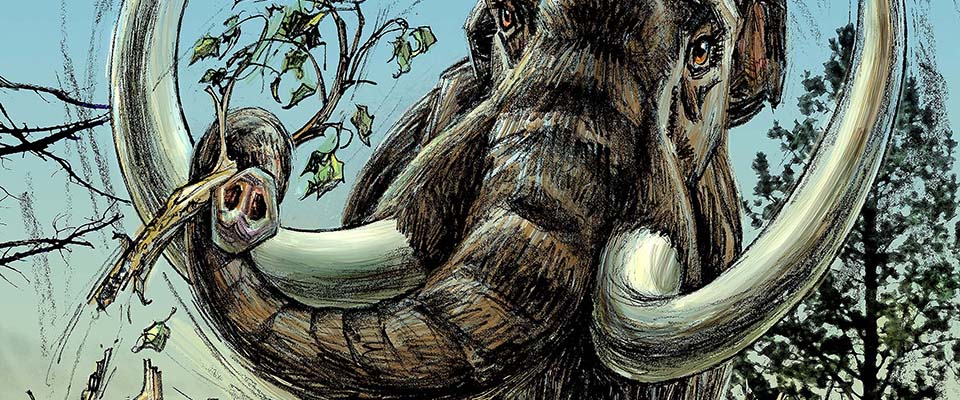Why does North America have so many trees and so few elephants?
One of the many mysteries in the fossil record is the late-Quaternary extinction, that wholesale shift of plant and animal life as the Ice Age ended at the close of the Pleistocene and the beginning of the Holocene, a die-off that included about half of the world’s large-bodied animals. Forests grew up, and into the tar pit went the saber-tooth tiger, giant horses, five-ton sloths, and honking big mammoths and mastodons.
These animals thrived in mosaic ecosystems, with grasslands and forests abutting and blending together. As biologists and observant hikers know, you see more animals where forests and fields meet than you do, say, deep in the woods. Blended landscapes support a greater variety of plants and animals, and the flora and fauna of the prehistoric Americas were rich in diversity. So what happened?
The classic explanation is that the climate changed at the end of the Pleistocene in a way that favored denser forests, which extinguished the last of the megafauna between 13,000 and 11,000 years ago.
But that explanation seems insufficient, says Anthony Barnosky, a UC Berkeley professor of integrative biology and curator of the University’s Museum of Paleontology. What if the story is the other way around? Big animals, after all, can have a big influence on their ecosystems. What if we lost our megafauna and then the landscape changed?
“If you cause extinctions of certain megafauna,” Barnosky says, “you irrevocably change the ecosystem in ways that go much farther than just pulling those big animals out.”
Without proboscideans, the understory grows up, the forest becomes denser and taller, and the wide web of animals starts to contract, with a great die-off of small mammals. The entire ecosystem is changed.
But some animals are more equal than others. The crucial ones, Barnosky explains, are “ecosystem engineers”—animals that dramatically reshape the landscape to suit their own needs. And no class of animal is better suited to that than proboscideans, which are not latex-schnozzed Star Trek extras, but big, grazing animals with trunks. Back then, proboscideans were mammoths and mastodons.
“They not only eat the vegetation, not only the trees that are sprouting, but actually knock over [trees] and trample and wreak all sorts of havoc on the soils and the vegetation,” Barnosky says. “The net effect is, it keeps the landscape much more open, much less forested, which allows a greater diversity of shrubs and grasses, which in turn supports a greater diversity of small mammals and insects and so on.”
Without proboscideans, the understory grows up, the forest becomes denser and taller, and the wide web of animals starts to contract, with a great die-off of small mammals. The entire ecosystem is changed.
“The basic argument people have been having for 40 or 50 years is, Was it climate change that made climates unsuitable for them, or was it humans coming in and hunting them out? Our research convinces us it was a little bit of both.”
Elephants are today’s proboscideans and they are every bit as vital to creating Africa’s mosaic of forest and savanna. “They’re like bulldozers that just go into a forest and, if something’s in their way, they just knock it over. Plus, they strip the bark off of trees; they eat the bark. There are certain trees that they like the way the bark and the cambium tastes,” Barnosky says. “I’ve been in parts of Africa where it sounds like a construction site.”
We could see a Quaternary-style ecosystem collapse in our own lifetimes, Barnosky says, if we don’t protect Africa’s elephants. “If you look at the modern African landscape and look at places that have so-called normal densities of elephants versus those that have had the elephants poached out or hunted out or otherwise removed, you see much the same effect.”
So what killed off North America’s mastodons and mammoths? Just as has happened today with elephants, one likely culprit is humanity. The massive declines in prehistoric megafauna happened around the time we showed up.
“The basic argument people have been having for 40 or 50 years is, Was it climate change that made climates unsuitable for them, or was it humans coming in and hunting them out? Our research convinces us it was a little bit of both. Certainly in North and South America, the first arrival of people had a very definite impact in reducing population sizes,” Barnosky says. “But there are some nuances that suggest that, had the climate not changed the way it did, then these large animals would have survived a lot longer than they did, even in the presence of humans.”
Brendan Buhler is a frequent contributor to California and is himself native Bay Area megafauna.


















